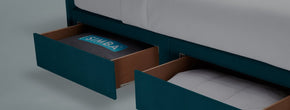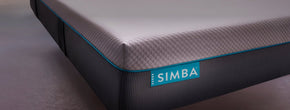They are known as our four-legged best friend and a fully-fledged member of the family… but do our beloved dogs really make the best sleep partners?
Whilst the debate is ongoing when it comes to sharing your bed with your dog, a recent study revealed that almost half of UK dog owners (48%) continue to embrace their devoted fur balls when it comes to burrowing under the duvet at night and snuggling down on the “big bed”.
But does this make for a better or worse night’s sleep?
Sleep tech firm Simba, together with leading animal behaviourist Professor Peter Neville, have [without judgement!] pulled back the covers on this hotly debated topic to understand the pros and cons when it comes to nature - not nurture - behind canine co-bed-habiting.
The study from Simba, based on the UK’s top 20 most popular canines, analysed the co-bed sleeping habits of over 1,000 UK owners to understand better which breed is the best - and worst - bed partner, as well as looking at dog sleeping quirks such as snoring, wriggling, and passing wind, which could be impacting our precious slumber.
Top of the sleep fellow “pup-pop charts” are Labrador Retrievers - a family favourite - and despite taking up copious amounts of room [and being pretty hairy] secures the #1 spot as best canine bed fellow.
The research confirms pet parents of Labrador Retrievers are less likely to suffer from insomnia, sleep apnoea, or snoring.
What’s more, they report that the breed won’t move a muscle throughout the night - which could be why they clock more sleep than owners of other breeds - averaging 6 hours a night.
Professor Peter Neville comments: “Labrador Retrievers are persistently and by far the most popular breed and are famously quick to learn about how to appeal to their humans. They soon come to know that stillness is key, and not to stir or make any noise, unless it’s to defend the home.
“Labradors are so popular because they are always ready to play, easy to train, and find it easy to train us too - and soon adapt to match our activity and rest/sleep cycles. It all adds up to a dog that just wants to spend as much time as possible with us, including sleeping beside us all night long.”
In at #2 is the Dachshund.
Also consistently ranked as one of the most popular breeds based on their playfulness and their natural instinct to stay close, whilst also being small enough to take anywhere, they are now having their moment du jour globally in human society, as well as the UK, with over 9.5 billion views of #Dachshund on TikTok.
Professor Neville adds: “This is a breed that, like Terriers, loves to burrow into dark places. It’s in the genes, as they were developed bravely to seek out vermin and prey in their burrows for us. But their modern tasks as companions include being a pocket hot water bottle - great for chilly UK climes - they make great bed companions.
“But watch out, because being fearless in the dark as a consequence of their original hunting function, they might just try to seize ownership of the whole bed - especially if you turn the heating off at night - as they will rely on the warmth of the bedcovers!”
Bottom of the pile are the affectionately named “velcro dogs” - aka Hungarian Vizslas.
Needy in the day and anxious during evenings, owners of the breed report the highest levels of sleep apnoea, teeth grinding, and twitchy legs at night.
It’s bad news for Vizsla pet parents, as on average, they clock just under 5 hours sleep a night thanks to the restlessness of their usually fit, active, and always ‘ready-to-go’ four-legged friend.
Professor Neville says: “This is a breed designed to work and run all day as a hunting companion. Many owners, attracted by their huge characters and gorgeous, sleek, golden-rust looks, struggle to fulfil their behavioural needs and use up their energy in the daylight.
“The net result is a dog that is often still raring to go come bedtime, and one who sleeps fitfully perhaps in anticipation of tomorrow’s activities and maybe dreams about the excitement of the day just past!”
Meanwhile, the affectionate and playful German Pointer came in second to last.
In need of lots of exercise and not one to sit around being content, the study from Simba found that bed sharers of the breed are the most likely to wake up feeling too hot in the night - and then rise feeling grumpy and irritable in the morning.
The research suggests this may be because German Pointers wriggle around more at night - while also sharing bad breath!
Peter adds: “The bad breath reported may be down to the diet and dental hygiene of those dogs in the survey, but as a larger, muscly breed, short, long and especially wire-haired pointers may struggle to lose heat if the bed and the room are very warm.
“After all, dogs only have sweat glands on their nose and in their feet - so they must rely on panting and getting to cooler places if they get too hot. Meaning that they might wake up regularly and shift around a lot on a warm bed in a warm room.
“The panting and a sweating, twitchy nose not only keeps them awake but it also results in hot breath which only further disseminates any halitosis into the room. No wonder owners don’t sleep much either!
While Whippets [in at #17] rated highly for offering their owners 'a sense of companionship, safety and security', which is great for humans, but the benefits need to be weighed up against the fact they are most active at night for wriggling around, passing wind and making noises while their owners are trying to sleep.
Peter comments “The wind problem reported is likely down to diet and could be improved by a change of food. If a Whippet or any dog is having digestion issues at night, then it’s quite likely to lead to discomfort - which leads to them shifting position and wriggling about. This may cause gurgling and flatulence.
“Changing the timing of meals might also help - feeding earlier in the day rather than in the evening. It’s always worth a discussion with the vet and then perhaps everyone will sleep better!
When it comes to the ultimate canine culprits for snoring and passing wind at night, popular status dogs Staffordshire Bull Terriers and French Bulldogs are the worst offenders. While Bull Terriers and Bulldogs have the worst breath.
Flat faced breeds are notorious for the respiratory noises they make - whether snoring or snorting - and interestingly, their snoring habits seem to rub off onto their humans… with pet parents of Bull Terriers, French Bulldogs, and Staffordshire Bull Terriers all reporting the highest levels of snoring - more so than any other breed on the list.
What’s more, the study found that Staffordshire Bull Terriers cause their owners to wake up more regularly through the night and then wake in the morning feeling tired and sleepy.
Peter adds “Unfortunately, the snoring is largely down to the facial design and throat structure of brachycephalic (flat faced) breeds. Even normal breathing is noisy for some, because of their restricted airways.
“This gets ever nosier in hot weather, or if they become more active and need to breathe faster and deeper to get enough oxygen. As a result, they often tire quickly, and so the breathy snorting may be short-lived.
“At night, the warmer they get, they more they need to pant to lose the heat - and so the more they wheeze and snore and wake themselves - and their human.
“It all leads to insufficient sleep, even on the most comfortable of beds and softest of bedding - and is likely to lead to the morning irritability reported in the survey.
“In severe cases, sleep apnoea can lead to CO2 levels rising dangerously in the dog’s bloodstream, causing them to startle awake in a panic. Veterinary advice should be sought urgently in such cases and sleeping arrangements and places may need to be changed, no matter how snuggly these breeds may be for their human bed mates.”
Professor Peter Neville’s Top 6 Dos and Don'ts of Sleeping with your Dog
1) DO keep the room cool
Remember that most dogs come with their own fur blanket to insulate them in the cold. So they respond far quicker than we do to an increase in temperature - either in hot weather or in or on a warm bed at night.
Long or thick coated breeds are more likely to warm up much faster than short thin coated breeds, some of whom feel the cold easily and need a warmer room and bed, and even a coat in cold weather.
Much like humans, when the bedroom is too hot, our furry friends will be restless and struggle to snooze, let alone sleep. So look to keep the room cool by turning the heating off or down, by letting some air in - by cracking open a window if safe to do so, or by using a fan or air conditioner.
A temperature savvy duvet, such as Simba’s Hybrid 3-in-1 duvet, designed with cooling Stratos® technology, works as two duvets for Spring/Autumn (7 Tog) and Summer (3.5 Tog) for warmer nights - and the two together for colder nights.
2) DO your best to tire your pooch out before bedtime with exercise and play
Results from the study show that our dogs can be very active during the night. However, if you try and use up some of that pent up energy by exercising them before bedtime, they will likely be more tired and sleep deeper and longer, and so might you!
Take them for an evening run or stroll to wind them down before turning in, if possible, or alternatively, give them a 10-15-minute blast of active play time indoors with chase and/or tug toys to help wear them out.
Remember to follow that with a few minutes calming wind-down of stroking and maybe grooming to relax them and get them ready for sleep.
3) DON’T feed them or give them too much water before hitting the hay
We have all been there before.. when we drink too much too close to bedtime, and then wake in the night with a full bladder needing to go to the toilet. Or when we eat too much and then suffer from indigestion and discomfort and can’t get to sleep.
Well, our canine companions are no different. To help reduce their nocturnal activity, feed them their last meal of the day earlier, perhaps mid-afternoon.
And other than in hot weather or quickly right after a last walk or play session, maybe restrict access to the water bowl an hour or two before they go to bed.
4) DO keep your canine comfortable and calm
About half an hour before you start getting ready to go to bed, and after the last walk and play session with your pooch, distance yourself from them a little - and do your best to ignore any attempts to keep playing, so that they settle down as much as possible.
Reserve a few minutes to wind your dog down from any excitability with a few minutes of calm stroking and brushing to relax them and prepare them for going to bed.
Once you are all tucked up, continue to pet them when you read or watch tv so that they drop off to the land of nod before you - ideally in the best sleeping position for you both.
5) DO regularly wash and change your bed sheets
With all the outdoor walks and whizzing around the house, our dogs can pick up all sorts of dirt and germs on their paws, face, and coats. Which is why pet parents should always look to have only a clean and dry dog in the bedroom.
It's also important to regularly change and clean bedsheets - making sure to wash them on a high heat to kill off bacteria.
For the best night's sleep, Simba’s Performance Bed Linen is made from 100% cotton, a naturally breathable fabric that feels soft and smooth for humans and canines alike. Not to mention the linen has a Simba Stratos finish to help dissipate excess body heat.
6) DO get a bed as big as possible
Simple, yet effective: making sure you have a large bed means there’s room enough for everyone - with dogs of any size and any number spread out however they like to sleep in comfort.
This allows plenty of space for their humans (whose bedroom it used to be) to enjoy a good night’s sleep too, safe in the company of their best friends and protectors.
The Simba Hybrid® Pro Mattress is designed with up to 4,000 Aerocoil® springs nestled in the uppermost layers for superior comfort, while a British wool layer ensures better temperature regulation.
Lisa Artis, deputy CEO at The Sleep Charity, sleep tech firm Simba’s charity partner, said “Although sharing a bed with our canines isn't conducive to the most peaceful night’s sleep, the study found that the benefits they bring us can really outweigh their nocturnal activity.
“Despite disrupting our slumber, the sense of safety, security, companionship, and happiness we experience from bunking up with our dogs is worth all the wriggles, snores, and sleep noises they make. So although we wouldn't actively endorse dogs sleeping on our beds, they do contribute to our overall wellbeing and mental health.”
To rate your four-legged friend on their sleep habits. check out our quiz below.














